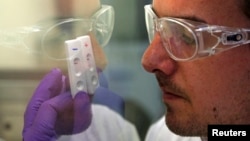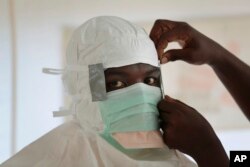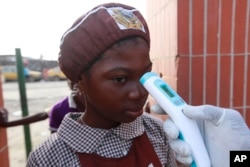As it stands now, treating Ebola-infected people is a race against time.
It is a race that 44-year-old Martin Salia, a native of Sierra Leone, lost this week when he died very shortly after being flown from Sierra Leone to the United States for treatment.
Salia was the chief medical officer and surgeon at the Kissy United Methodist Hospital in Sierra Leone’s capital, Freetown, where he contracted Ebola. By the time he arrived at a specialized treatment facility in Nebraska, he was already in critical condition, and despite intensive medical intervention, he died.
His story is a case in point of the conundrum presented by the current outbreak.
"For Ebola…you get virus in a detectable place, which is really the blood, [when] or slightly after you see signs of infection,” said Dr. John Connor, a microbiologist at the University of Boston who has studied Lassa and Marburg viruses, both closely related to Ebola.
“And so if you wait for them to show signs of disease and then maybe a couple of other extra days for [the] virus to be very plentiful in the blood so you can see it with current diagnostics, that therapeutic window is slipping away from you,” he said.
Researchers are working to close that window by creating a diagnostic test that will indicate exposure to the virus much sooner. Faster diagnoses would allow more time for treatment, isolation and contact tracing with the aim of stemming the current epidemic, which the World Health Organization estimates has killed more than 5,100 people.
To do that, scientists are faced with trying to detect something that is not yet present.
"Essentially the question was, can we look in the blood and try and find early markers that might indicate that the host is responding to the disease in a way that we can track that as early as possible,” said Connor.
Working with scientists at the United States Army Medical Research Infectious Disease Institute (USAMRIID) in Maryland, he successfully identified markers in Lassa and Marburg viral infections.
And the so-called “sequencing data” of a similar USAMRIID study of Ebola-infected macaque primates is now ready for Connor’s team to analyze.
Silent infections
Another line of inquiry is looking into why some people who are Ebola-infected never get sick, a phenomenon known in scientific circles as “asymptomatic Ebola infection.”
“People can be exposed to the virus, develop an infection but never know it because their body successfully fights it off,” said Dr. Steve Bellan, a researcher at the Center for Computational Biology and Bioinformatics University of Texas at Austin. Bellan reviewed all the available data on asymptomatic Ebola infections, the results of which were published in a letter to The Lancet journal.
“And there is actually substantial evidence that this happens relatively frequently, particularly from one study of an outbreak in Gabon in 1996, where they did a lot of virological and immunological work,” said Bellan.
In the Gabon study of the 1996 outbreak, researchers monitored 24 contacts of known Ebola cases that never became sick and found that 46 percent of these individuals – a total of 11 people – were infected but never became sick. They also discovered that they mounted immune responses, finding tiny amounts of virus that were present for a very short time before their immune systems kicked in.
That response indicates that the infected person may – emphasis on may – develop protective immunity, a key distinction.
“The fact that someone develops an immune response shows that they were exposed to the virus, but it doesn’t necessarily mean that they are immune,” he said. “If they were exposed again, then they might successfully fight it off and they might not. We don’t really have enough evidence to know whether it’s protective yet.”
This scientific query could yield very practical applications in the form of faster disease control measures, including a vaccine, and putting Ebola immune people on the frontline of caring for Ebola patients, preventing the spread to non-immune health workers.
But further study of silent infections is very difficult, according to Dr. John Schieffelin, an assistant professor at Tulane University’s School of Public Health and Tropical Medicine in New Orleans, in part because the spectrum of Ebola disease is enormous, he said.
“There were a lot of people who I was convinced that they had been sent there by some kind of error, just totally couldn't believe that anybody would have thought that they might have Ebola. And almost all of them turned out to be positive,” said Schieffelin, who spent several weeks working in Sierra Leone this fall and co-authored the results of a study of Ebola patients from the current outbreak.
“And there was the minority of people who showed up with what we all imagine is the classic Ebola patient, who had a lot of bleeding and were really, really sick, and obviously did really poorly. And then things in between."
Researchers point out it is very difficult to find out how many people are asymptomatic because they don’t seek treatment – and, as such, do not get registered and identified in any healthcare system.
Alongside efforts to come up with a vaccine, Bellan believes the idea of delving more deeply into asymptomatic Ebola infections is beginning to catch on.
“It’s still quite early,” he said. “To do this you have to be collecting blood in outbreak settings, which has its own risks. And these studies have to be done very carefully.”
Watch related story by VOA's Cindy Saine, "Obama, Congress Agree to Keep Focus on Ebola Fight"











